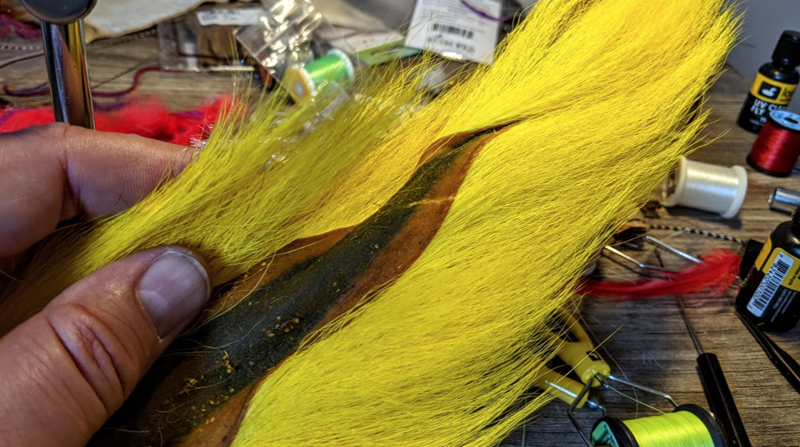
A typical dyed bucktail. The hairs near the tips are great for Clousers and Deceivers. The closer you get to the base, the more flare you’ll get when you tie the material to your hook. Photo by Chris Hunt
Bucktails are easy to source
By Skip Clement with quotes from Martin Joergensen, Global flyfisher, and Chris Hunt of Trout Unlimited
Bucktail hairs are a big part of streamer ties and saltwater flies. Better performing, many say, than synthetics which have become popular with most tyers.
When buying a bucktail, always take it out of the bag to inspect it. Look for uniform, straight, soft hair. Depending on your use, you might want finer and softer hair (traditional streamers), or coarser and longer hair for pike and saltwater flies. The longer hair usually sits on the sides and tip of the tail; it can be seen better from the back – the shorter and more steeply tapered hair is in the center front and top of the tail.
when I started fishing bigger water, and when I started chasing fish in saltwater, I had to get my head around tying with bucktail, and now, I’m fairly adept at using this material. Honestly, it took some trial and error, but, with the help of other tiers—particularly the tying pros that host YouTube tutorials—I’ve come to realize that bucktail is actually one of the most forgiving tying materials available. — Chris Hunt / TU
Bucktails are available in natural colors like white and brown and in almost any dyed color you can imagine
When buying dyed hairs, the darkest will be in the middle, meaning that the brightly colored hairs are the longer side hairs. Even a consistent dye job will rarely lead to a uniform color, but on the other hand, often give some hues, like two tones of olive, gray and blackish, yellow and bright olive, which can all be useful. Black is usually the only color that penetrates all hair on the tail.
When store bought, make sure there are no broken hair tips
The tapered tips are the most used in bucktail flies. Broken tips mean that you will have to sit and remove single hairs once you have picked and stacked a bunch. The fractured tips can also be a sign of a dry tail, which has been stored for a long time and is getting brittle.
You want a smooth, flat and symmetrical skin without curled parts – neither on the skin side nor in the hairs. The hairs might be saved with washing or steam, but the skin is hard as wood, and not easy to straighten. — Martin Joergensen, Global flyfisher
When buying online, know who you’re dealing with
When cleaning your kill, or getting “wild” bucktails from another source, consider their placement on the animal. Make sure you lift the hairs and check for patches of “sh*t” on the skin. It can be washed clean.
You can get fresh kill bucktails from butchering outfits specializing in game meat
Here is a video showing how to prepare wild-caught deer bucktails
Here is a video on how to tie with bucktails – Rich Strolis






